To Be The Best: The top 100 boxers in the history of The Ring Rankings (40-31)

If you’re new to this on-going series, please read:
The Introduction. (Seriously, if you’re posting questions like “What does the asterisk next to some results mean?” in the comment section, you really need to read this.)
***
The one active fighter in this sensational group is sure to elicit groans from a “salty” segment of hardcore fandom. Saul Alvarez is the biggest star in the sport, as well as the undisputed super middleweight champ and No. 1 in The Ring’s pound-for-pound rankings, but he’s got his share of detractors.
They should understand that the four-division titleholder is an experienced 31, having first entered The Ring’s rankings in August 2010. His impressive body of work has placed him in the company of a top-five heavyweight great and some of the most popular and celebrated fighters in the history of the sport.
Their names and legacies are as synonymous with their fighting monikers as Alvarez is with “Canelo.” People who don’t watch boxing know about “Hands Of Stone,” “The Hitman,” and “The Raging Bull.”
There are also some forgotten champs of the 1920s, ’30s and ’40 – all very popular in their day – mixed in this group.
***
#40 – Louis “Kid” Kaplan
Career Record: 107-22-13, 17 No Decisions, 1 No Contest (27 KOs, 3 KOBY)
First Ring Ranking: #1 Featherweight (February 1925)
Last Ring Ranking: #3 Jr. Welterweight (October 1932)
Record vs. Ring-rated Opponents: 26-10-5, 1 No Contest (6 KOs, 3 KOBY)
Overall Score Rank: 66
Peak Score Rank: 64
Win Total Rank: 15
Ring Magazine Championships: Featherweight (1925)
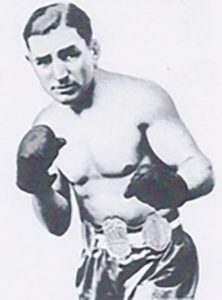
Louis “Kid” Kaplan was a respected and popular featherweight champion during the 1920s.
Born in Ukraine and raised in Connecticut, it’s hard to say when Kaplan would have entered the ratings had there been Ring rankings prior to 1925 but his activity from 1924-32 represents a sizable chunk of his career. Crafty and physical with a smart left hook, Kaplan stayed in the mix from featherweight to lightweight for more than a decade.
Kaplan’s stay as featherweight champion was brief but earned. Kaplan worked through a tournament to replace Johnny Dundee as champion, attaining his goal with the knockout of Danny Kramer. Kaplan defended successfully against Babe Herman and Bobby Garcia but fought most often near the lightweight limit and relinquished his title in 1926. Kaplan had some short stretches as the number two contender at lightweight over the ensuing years, and was the leading contender to Sammy Mandell in the July 1929 issue, but never fought for another title.
Missing Quality: Prior to 1924, Kaplan already had several solid victories over men whose names could be found in early Ring annual rankings like Steve Sullivan, Eddie Wagner, Babe Herman, Allentown Johnny Leonard, and Jimmy Goodrich. A win over Billy Petrolle in the first half of 1926 didn’t count towards his finish here but is notable as Petrolle would enter the rankings in the 1927 annual. Kaplan’s final fight is also worth a note. Kaplan has exited the rankings for the last time already when he suffered defeat to a young Cocoa Kid just months before the Cuban entered the rankings for the first time.
Scoring Results:
[Cuddy DeMarco D 10 – (UR) – 126
Bobby Garcia D 12 – (6) – 126
Cuddy DeMarco D 12 – (UR) – 126
Bobby Garcia W 12 – (6) – 126
Lou Paluso W 12 – (4+) – 130
Bobby Garcia W 10 – (6) – 126
Jose Lombardo KO 4 – (5) – 126
Danny Kramer TKO 9* – (4) – 126
Bud Ridley ND 12 – (10) – 126
Steve Sullivan TKO 5 – (1+) – 130 – 02/25]
[Babe Herman D 15 – (2) – 126
Babe Herman UD 15 – (2) – 126
Eddie Wagner D 10 – (UR) – 126
Leo Roy KO 7 – (10) – 126
Bobby Garcia TKO 10 – (4) – 126 – 02/26]
[Billy Wallace KO by 5 – (3) – 135
Jackie Fields W 10 – (9) – 135
Bruce Flowers W 10 – (10) – 135 – 02/27]
[Tommy Cello W 10 – (11) – 135
Jimmy McLarnin KO by 8 – (2) – 135
Mike Dundee W 12 – (4-) – 130 – 02/28]
Manuel Quintero L 10 – (UR) – 135 – 06/28
Manuel Quintero L 10 – (4) – 135 – 08/28
Freddie Mueller DQ by 8 – (UR+) – 140 – 03/29
[Joe Glick W 10 – (3) – 135
Joe Medill W 10 – (8) – 135 – 05/29]
Billy Wallace W 10 – (1) – 135 – 06/29
Emory Cabana L 10 – (UR) – 135 – 10/29
[Eddie Wolfe RTD 7 – (10) – 135
Emory Cabana W 10 – (5) – 135 – 12/29]
Andy Callahan W 10 – (8) – 135 – 01/30
Jack Portney L 10 – (UR) – 135 – 03/30
Johnny Farr W 10 – (3-) – 130 – 04/30
Joey Medill W 10 – (5+) – 140 – 07/30
Maurice Holtzer W 10 – (8-) – 130 – 08/30
[Battling Battalino W 10 – (C–) – 126
Justo Suarez L 10 – (3) – 135 – 11/30]
Ralph Lenny W 10 – (6+) – 140 – 05/31
Sammy Mandell W 10 – (7+) – 140 – 10/31
Eddie Ran KO by 1 – (UR++) – 147 – 12/31
Frankie Petrolle W 8 – (5) – 140 – 09/32
Pancho Villa L10 – (UR) – 140 – 10/32
#39 – Beau Jack
Career Record: 91-24-5 (44 KOs, 4 KOBY)
First Ring Ranking: #9 Lightweight (November 1942)
Last Ring Ranking: #6 Welterweight (December 1949)
Record vs. Ring-rated Opponents: 18-9-2 (4 KOs, 2 KOBY)
Overall Score Rank: 55
Peak Score Rank: 47
Win Total Rank: 43
Ring Magazine Championships: None
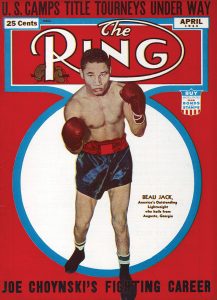
Beau Jack adorned the cover of the April 1943 issue of The Ring. He was Ring’s 1944 Fighter of the Year.
Born Sidney Walker in Augusta, Georgia, Beau Jack was one of the most exciting fighters of the 1940s and a tremendous draw at Madison Square Garden. Jack rose to number one contender for the first time in the January 1943 issue on the eve of capturing the first of two NYSAC lightweight crowns from Tippy Larkin. Jack would trade the crown with Bob Montogomery three times between 1943-44. Jack would move in and out of the top contender’s slot from 1943 until falling out of the top ten in the June 1945 issue “following the usual procedure in cases of boxers who are in the service and are not permitted to fight professionally.” When Jack resumed his career, he entered the welterweight top ten in the February 1946 issue.
Jack would move between the rankings at welterweight and lightweight for most of the back half of the decade. Jack would climb as high as number two on several occasions but never competed for the welterweight crown. Jack did receive a shot at Williams for the lightweight crown in 1948. It was the first in a four-fight series, Jack losing three and securing a draw.
Missing Quality: The first fight with Williams was the only bout between the two where both were ranked. A win over Lulu Constantino in January 1944 came between stints in the top ten at featherweight and lightweight for Constantino. Jack handed Sammy Angott the lone stoppage loss of Angott’s career in 1946 but Angott had already exited the rankings for the final time earlier in the year. Tony Janiro’s name was regularly found at welterweight, and later middleweight, during the 1940’s and early 50’s. When Jack defeated him in 1948 to avenge a previous loss, Janiro was unranked.
Scoring Results:
Chester Rico W 8 – (3) – 135 – 11/42
Allie Stolz TKO 7 – (1) – 135 – 12/42
Tippy Larkin KO 3 – (5) – 135 – 02/43
Fritzie Zivic UD 10 – (8+) – 147 – 03/43
Fritzie Zivic UD 12 – (10+) – 147 – 04/43
Henry Armstrong UD 10 – (2+) – 147 – 05/43
Bob Montgomery L 15 – (2) – 135 – 07/43
Johnny Hutchinson TKO 6 – (8) – 135 – 09/43
Bobby Ruffin L 10 – (8) – 135 – 11/43
Bob Montgomery UD 15 – (1) – 135 – 01/44
Sammy Angott D10 – (2) – 135 – 03/44
Bob Montgomery L 15 – (3) – 135 – 04/44
[Al “Bummy” Davis UD 10 – (1+) – 147
Juan Zurita UD10 – (2) – 135 – 05/44]
Bob Montgomery MD 10 – (1) – 135 – 09/44
Willie Joyce UD 10 – (3) – 135 – 01/46
Johnny Greco D 10 – (8) – 147 – 03/46
Johnny Greco UD 10 – (4) – 147 – 07/46
Danny Kapilow UD 10 – (9) – 147 – 10/46
Buster Tyler L 10 – (UR) – 147 – 12/46
Tony Janiro TKO by 4 – (4) – 147 – 04/47
Johnny Bratton TKO 8 – (7-) 135 – 03/48
Terry Young L 10 – (10) – 135 – 04/48
Johnny Greco MD 10 – (7+) – 147 – 05/48
Ike Williams TKO by 6 – (C-) – 135 – 08/48
Johnny Greco L 10 – (7) – 147 – 05/49
Eddie Giosa UD 10 – (9-) – 135 – 08/49
Johnny Gonsalves SD 10 – (6-) – 135 – 10/49
Kid Gavilan L 10 – (1+) – 147 – 11/49
#38 – Jake LaMotta
Career Record: 83-19-4 (30 KOs, 4 KOBY)
First Ring Ranking: #9 Middleweight (July 1942)
Last Ring Ranking: #9 Light Heavyweight (February 1953)
Record vs. Ring-rated Opponents: 24-15-3 (5 KOs, 4 KOBY)
Overall Score Rank: 63
Peak Score Rank: 60
Win Total Rank: 19
Ring Magazine Championships: Middleweight (1949-51)
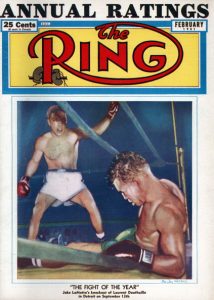
The February 1951 cover of The Ring featured an illustration of the dramatic climax of the Jake LaMotta-Laurent Dauthuille middleweight championship, which was The Ring’s 1950 Fight of the Year.
Immortalized in the classic film “Raging Bull,” LaMotta went by “Bronx Bull” in the ring, battering his way forward with a clever, physical style for nearly a decade before he secured a shot at the title. LaMotta moved in and out of the top ten before landing at number one for the first time in the April 1943 issue, the reward for handing leading welterweight contender Sugar Ray Robinson his first professional loss. LaMotta would hold the top contender spot often for the next few years, including an uninterrupted stretch from the August 1946-October 1947 editions. Almost two years later, by then ranked ninth, LaMotta stopped Marcel Cerdan for middleweight honors.
LaMotta would defend the title twice before losing it to his most notable nemesis. His series with Robinson ended in Robinson’s favor 5-1 though some observers felt LaMotta deserved at least one more in his favor. In 1952, LaMotta would climb as high as third in the light heavyweight rankings but never fought for another title.
Missing Quality: Initial research errantly omitted LaMotta’s draw with Jose Basora as a scoring component, lowering LaMotta’s finish. LaMotta later admitted before the Kefauver Commission he had thrown the fight with Billy Fox to gain favor toward a title shot at middleweight. It was a factor keeping him out of the defunct Ring Magazine Hall of Fame for years and worked out for Fox who went on to a second failed shot at Gus Lesnevich for the light heavyweight title. LaMotta just missed credit for a win over Tommy Yarosz; Yarosz fell out of the top ten at light heavyweight in the January 1949 issue on the eve of their fight only to return for more than a year uninterrupted. Bert Lytell was unranked in the June 1945 issue on the eve of his loss to LaMotta but entered the top ten for the first time in the next edition. Bob Murphy was unranked in the issue prior to LaMotta’s 1952 revenge win but returned to the light heavyweight top ten immediately afterwards.
Scoring Results:
Jose Basora D 10 – (UR) – 160 – 06/42
Jose Basora L 10 – (UR) – 160 – 08/42
Sugar Ray Robinson L 10 – (1-) – 147 – 11/42
[Jimmy Edgar SD 10 – (6-) – 147
Jackie Wilson W 10 – (3-) – 147 – 02/43]
Sugar Ray Robinson UD 10 – (1-) – 147 – 03/43
Sugar Ray Robinson L 10 – (1-) – 147 – 04/43
Fritzie Zivic SD 10 – (4-) – 147 – 07/43
Fritzie Zivic L 15 – (3-) – 147 – 08/43
Jose Basora UD 10 – (2) – 160 – 11/43
Fritzie Zivic SD 10 – (2-) – 147 – 12/43
Fritzie Zivic UD 10 – (2-) – 147 – 03/44
Coley Welch UD 10 – (4) – 160 – 05/44
Lloyd Marshall L 10 – (1+) – 175 – 06/44
George Kochan UD 10 – (6+) – 175 – 11/44
George Kochan TKO 9 – (9+) – 175 – 12/44
Sugar Ray Robinson L 10 – (1-) – 147 – 04/45
Vic Dellicurti UD 10 – (9) – 160 – 06/45
Tommy Bell UD 10 – (5-) – 147 – 08/45
Jose Basora TKO 9 – (6) – 160 – 09/45
[George Kochan TKO 9 – (3+) – 175
Sugar Ray Robinson L 12 – (1-) – 147 – 11/45]
Tommy Bell UD 10 – (7-) – 147 – 02/46
Jimmy Edgar D 10 – (6) – 160 – 08/46
Holman Williams UD 10 – (9) – 160 – 09/46
Tommy Bell UD 10 – (1-) – 147 – 05/47
Tony Janiro UD 10 – (4-) – 147 – 07/47
Cecil Hudson L 10 – (UR) – 160 – 10/47
Billy Fox TKO by 4 – (2+) – 175 – 01/48
Laurent Dauthuille L 10 – (UR) – 160 – 04/49
Robert Villemain SD 12 – (9) – 160 – 05/49
Marcel Cerdan RTD 9* – (C) – 160 – 07/49
Robert Villemain L 10 – (10) – 160 – 01/50
Tiberio Mitri UD 15 – (3) – 160 – 08/50
Laurent Dauthille KO 15 – (2) – 160 – 10/50
Sugar Ray Robinson TKO by 13* – (1) – 160 – 03/51
Bob Murphy RTD by 7 – (5) – 175 – 08/51
Norman Hayes L 10 – (UR-) – 160 – 03/52
Gene Hairston D 10 – (2-) – 160 – 04/52
Norman Hayes UD 10 – (8-) – 160 – 05/52
Gene Hairston UD 10 – (2-) – 160 – 07/52
Danny Nardico RTD by 7 – (5) – 175 – 02/53
#37 – Saul Alvarez
Career Record: 57-1-2 (39 KOs)
First Ring Ranking: #10 Jr. Middleweight (August 2010)
Last Ring Ranking: To Be Determined
Record vs. Ring-rated Opponents: 14-1-1 (8 KOs)
Overall Score Rank: 25
Peak Score Rank: 30
Win Total Rank: 81
Ring Magazine Championships: Jr. Middleweight (2013), Middleweight (2015-18, 18-21), Super Middleweight (2020-Present)
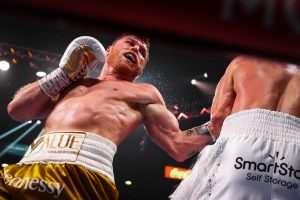
Canelo’s 11th-round KO of Caleb Plant earned him undisputed champion status at 168 pounds. He was Ring’s 2019 and 2021 Fighter of the Year. Photo by Amanda Westcott / SHOWTIME
The first active fighter on the list, “Canelo” is the reigning super middleweight champion and has been a presence in the rankings for more than a decade with no end in sight. Alvarez has faced Ring-ranked opposition in 17 of his last 23 starts with a single loss to Floyd Mayweather and a draw against Gennady Golovkin. Alvarez lost recognition from Ring as middleweight champion due to a positive test for a performance enhancing drug but won the Golovkin rematch to reclaim the throne.
To date, Alvarez has won alphabet titles in four weight classes. His first, a WBC belt at jr. middleweight, came against an unranked Matthew Hatton. Alvarez’s other belts have come against Ring-ranked opposition. Still only 31, Alvarez’s peak and win total scores can only get higher from here so there is room to grow should this list be revisited down the road.
Missing Quality: Alvarez’s Ring championship at jr. middleweight can be viewed as specious. Alvarez was ranked second, behind Mayweather, when he defeated the third ranked Trout for the vacant honor. A wait of one more fight would have yielded a 1-2 contest. Long before either cracked a top ten, Alvarez scored two decisions over future lightweight titlist Miguel Vazquez. A win over Shane Mosley came just a few issues after Mosley exited the rankings for the last time.
Scoring Results:
Ryan Rhodes TKO 12 – (4) – 154 – 08/11
Josesito Lopez TKO 5 – (8-) – 147 – 01/12
Austin Trout UD 12* – (3) – 154 – 06/13
Floyd Mayweather L 12* – (1) – 154 – 12/13
Erislandy Lara SD 12 – (2) – 154 – 09/14
Miguel Cotto UD 12* – (C+) – 160 – 01/16
Amir Khan KO 6 – (2–) – 147 – 08/16
Liam Smith KO 9 – (8-) – 154 – 12/16
Gennady Golovkin D 12 – (1) – 160 – 12/17
Gennady Golovkin MD 12* – (1) – 160 – 11/18
Rocky Fielding TKO 3 – (9+) – 168 – 03/19
Daniel Jacobs UD 12 – (2) – 160 – 07/19
Sergey Kovalev KO 11 – (2++) – 175 – 01/20
Callum Smith UD 12* – (C) – 168 – 03/21
Billy Joe Saunders RTD 8 – (4) – 168 – 07/21
Caleb Plant TKO 11 – (2) – 01/22
#36 – Peter Kane
Career Record: 89-8-2, 1 No Contest (54 KOs, 5 KOBY)
First Ring Ranking: #6 Flyweight (September 1936)
Last Ring Ranking: #8 Bantamweight (October 1948)
Record vs. Ring-rated Opponents: 20-7-2 (9 KOs, 5 KOBY)
Overall Score Rank: 50
Peak Score Rank: 50
Win Total Rank: 35
Ring Magazine Championships: Flyweight (1938-39)
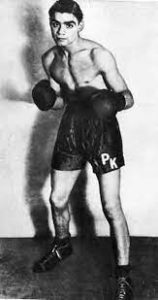
Peter Kane is one of the greatest British fighters of all time.
Kane is the highest finishing fighter in the study without election to the International Boxing Hall of Fame. The UK native made a mark at flyweight and bantamweight. Kane rose to number one contender and held the spot for all but three issues from April 1937-August 1938; he was ranked second in the other three. It overlapped with his first challenge of Benny Lynch in one of history’s most storied flyweight battles. Kane entered the first Benny Lynch bout at 42-0 but fell short.
Kane held Lynch to a draw in a rematch where Lynch missed weight. Kane was ranked at bantamweight for a few months before returning to win the flyweight title versus Jackie Jurich. Kane vacated the title in May 1939 to compete at bantamweight, though he would later return to the flyweight, ranked either first or second from the November 1942-May 1944 issues and failing in a bid to regain the title against Jackie Paterson. Like many boxers in his time, Kane’s career was interrupted by service in World War II, leaving Kane out of the ring for almost three years. After the war, Kane would rise to number one at bantamweight from the August 1947-April 1948 issues, winning the EBU crown but never getting another shot at a world crown.
Missing Quality: Kane defeated former bantamweight champion Baltasar Sangchili in 1939 with Sangchili nearly two years removed from the rankings. Norman Lewis was a stalwart in the flyweight and bantamweight rankings of the 1940s and early 50’s. Kane defeated him in 1942 and again in 46, both times with Lewis outside the rankings. Gus Foran would achieve top ten rankings at bantamweight and featherweight a couple years after Kane defeated him in 1943.
Scoring Results:
Enrico Urbinati KO 8 – (6) – 112 – 10/36
Valentin Angelmann W 12 – (5) – 112 – 01/37
Valentin Angelmann W 12 – (4) – 112 – 03/37
Pierre Louis KO 7 – (7) – 112 – 05/37
Ernst Weiss W 12 – (8) – 112 – 07/37
Jimmy Warnock TKO 4 – (1) – 112 – 10/37
Benny Lynch KO by 13 – (C) – 112 – 12/37
Benny Lynch D 12 – (C) – 112 – 05/38
Jackie Jurich W 15* – (C-) – 112 – 11/38
Pierre Louis KO 3 – (9-) – 112 – 09/39
Jackie Rankin TKO by 6 – (UR) – 118 – 04/40
Teddy O’Neil KO by 2 – (UR) – 118 – 11/40
Jimmy Lydon L 10 – (UR) – 118 – 04/41
Jimmy Stubbs TKO 7 (7-) – 112 – 08/41
Jimmy Stubbs W 10 (8) – 118 – 02/42
Joe Curran W 10 – (4-) – 112 – 07/42
Sammy Reynolds W 10 – (3-) – 112 – 08/42
Sammy Reynolds W 8 – (4-) – 112 – 09/42
Joe Curran KO 11 – (2-) – 112 – 10/42
Paddy Ryan TKO 6 – (7) – 112 – 01/43
Jackie Paterson KO by 1* – (1) – 112 – 08/43
Sammy Reynolds W 10 – (1) – 112 – 12/43
Bunty Doran W 8 – (6) – 118 – 04/47
Theo Medina TKO 6 – (4) – 118 – 07/47
Dado Marino W 10 – (1-) – 112 – 09/47
Guido Ferracin L 15 – (UR) – 118 – 04/48
Bunty Doran TKO 8 (10) – 118 – 06/48
Amleto Falcinelli D10 (UR) – 118 – 07/48
Guido Ferracin RTD by 5 – (1) – 118 – 09/48
#35 – Thomas Hearns
Career Record: 61-5-1 (48 KOs, 4 KOBY)
First Ring Ranking: #9 Welterweight (February 1979)
Last Ring Ranking: #8 Cruiserweight (August 1996)
Record vs. Ring-rated Opponents: 16-4-1 (13 KOs, 2 KOBY)
Overall Score Rank: 32
Peak Score Rank: 36
Win Total Rank: 59
Ring Magazine Championships: Jr. Middleweight (1983-86)
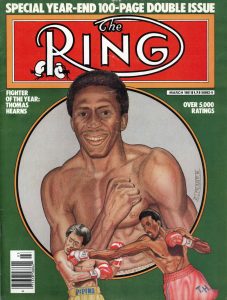
An illustration of a young Thomas Hearns graced the cover of the March 1981 issue of The Ring after he earned the 1980 Fighter-of-the-Year award.
The first man to win sanctioning body belts in five weight classes, Hearns used a whipping jab, laser like right hand, and excellent boxing skills to be one of the most exciting and accomplished fighters of his time. Hearns made short work of WBA titlist Pipino Cuevas for his first title and was the number one contender at welterweight from the October 1980-August 1982 issues.
Hearns fell short in a unification bout with Ring and WBC champion Sugar Ray Leonard but filled Ring’s vacant crown at jr. middleweight after a win over Wilfred Benitez. Hearns would hold the number one contender spot at middleweight for three lengthy stretches: the January-June 1985, May 1986-87, and the February-September 1988 issues. Hearns briefly held the number one spot at super middleweight in the April and May 1991 issues and, following a late career upset of Virgil Hill for his second belt at light heavyweight, topped the light heavyweight ranks. Hearns couldn’t solve Iran Barkley at middleweight or light heavyweight and never got a second crack at Hagler, but even Leonard gives Hearns credit as the rightful winner in their 1989 rematch draw, a super middleweight unification bout.
Missing Quality: While Hearns earned recognition from Ring as Jr. middleweight champion based on his win over Benitez, the printed rankings didn’t reflect the change until the July 1983 issue. On his way up the ranks, Hearns stopped unranked former Jr. welterweight titlist Saensak Muangsurin less than a year after Muangsurin lost his belt. Former Jr. middleweight champion Eddie Gazo was just less than two years removed from the rankings when Hearns halted a five-fight win streak by knockout. Doug DeWitt was ranked in Ring’s top ten at middleweight before and after a loss to Hearns, but not in the issue prior to their fight. Worth a footnote, in 1999 Hearns won a lopsided decision over former cruiserweight titlist Nate Miller. Hearns hadn’t been ranked for several years in any class and Miller fell out of the cruiserweight top ten in 1998. However, the win gave Hearns victories in his career against current or former titlists ranging from jr. welterweight to cruiserweight.
Scoring Results:
Clyde Gray TKO 10 – (2) – 147 – 03/79
Harold Weston RTD 6 – (10) – 147 – 07/79
Bruce Curry KO 3 – (7-) – 140 – 09/79
Mike Colbert UD 10 – (5+) – 160 – 01/80
Angel Espada TKO 4 – (7) – 147 – 04/80
Pipino Cuevas TKO 2 – (2) – 147 – 09/80
Luis Primera KO 6 – (9) – 147 – 01/81
Randy Shields TKO 12 – (5) – 147 – 06/81
Sugar Ray Leonard TKO by 14 – (C) – 147 – 10/81
Wilfred Benitez MD 15* – (1) – 154 – 01/83
Roberto Duran TKO 2 – (1) – 154 – 08/84
Fred Hutchings TKO 3 – (3) – 154 – 10/84
Marvin Hagler TKO by 3 – (C) – 160 – 06/85
James Shuler KO 1 – (2+) – 160 – 04/86
Mark Medal TKO 8 – (9) – 154 – 08/86
Dennis Andries TKO 10 – (3+) – 175 – 05/87
Juan Roldan KO 4 – (10-) – 160 – 01/88
Iran Barkley TKO by 3 – (6) – 160 – 09/88
Sugar Ray Leonard D 12 – (3) – 160 – 05/89
Virgil Hill UD 12 – (1) – 175 – 09/91
Iran Barkley L 12 – (4-) – 168 – 07/92
#34 – Kid Chocolate
Career Record: 136-10-6 (51 KOs, 2 KOBY)
First Ring Ranking: #8 Bantamweight (November 1928)
Last Ring Ranking: #6 Featherweight (March 1938)
Record vs. Ring-rated Opponents: 19-10-5 (3 KO, 2 KOBY)
Overall Score Rank: 57
Peak Score Rank: 31
Win Total Rank: 37
Ring Magazine Championships: Jr. Lightweight (1931-32), Featherweight (1932-34)
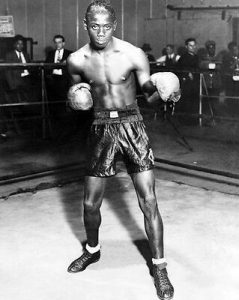
Kid Chocolate, who was wildly popular in New York City in the late 1920s/early 1930s, was recognized as both featherweight and jr. lightweight champ.
Born Eligio Sardinias Montalvo, the “Cuban Bon Bon” was one of the best featherweights and jr. lightweights of the early 1930s. Chocolate moved between the bantamweight and featherweight ranks, sometimes ranked in both, in late 1928 and the first half of 1929. Chocolate rose as high as number two at bantamweight in the June 1929 issue and was number one or two contender at featherweight from the August 1929-January 1931 issues. Chocolate lost in his first shot at a title, held off by featherweight king Battling Battalino, but made the most of his next opportunity.
Chocolate entered the jr. lightweight rankings at number one in the August 1931 issue on the eve of taking the crown from Benny Bass. Chocolate would hold the jr. lightweight crown until Ring withdrew recognition from the title in the October 1932 issue. Returning as the number one featherweight contender in the following edition, Chocolate would immediately defeat Lew Feldman to win the vacant Ring featherweight crown (also recognized by the NYSAC). Chocolate would also spend three months ranked in the top ten at lightweight, peaking with his debut ranking as number one contender in the January 1932 issue.
Missing Quality: Chocolate just missed credit for his final win over Feldman. Feldman fell out of the lightweight rankings a few months before their fourth contest in 1936 but returned to the top ten briefly in 1937. Pete Nebo was a regular in the early 1930s Jr. lightweight rankings and was in the top ten at Jr. welterweight a few months prior to a loss to Kid Chocolate in 1932. Another regular in the rankings, Davey Abad, slipped out of the Jr. lightweight top ten in the May 1932 issue on the eve of challenging Chocolate for the title. He immediately returned the following issue and remained for several months.
Scoring Results:
Joey Scalfaro D 10 – (9) – 118 – 12/28
Bushy Graham DQ 7 – (1) – 118 – 05/29
[Steve Smith UD 10 – (8++) – 130
Fidel LaBarba MD 10 – (3) – 118 – 06/29]
Gregorio Vidal SD 10 – (6-) 118 – 07/29
[Ignacio Fernández W 10 – (8) – 126
Steve Smith UD 10 – (9) – 126 – 08/29]
Al Singer SD 12 – (2+) – 130 – 09/29
Al Ridgeway TKO 2 – (6+) – 130 – 04/30
Jack Berg L 10 – (C+++) – 140 – 09/30
Fidel LaBarba L 10 – (3) – 126 – 12/30
Battling Battalino L 15 – (C) – 126 – 01/31
Benny Bass TKO 7* – (C) – 130 – 08/31
[Lew Feldman UD 10 – (10) – 130
Tony Canzoneri L 15 – (C) – 135 – 12/31]
[Lew Feldman UD 15 – (3-) – 126
Roger Bernard W 10 – (4) – 130 – 07/32]
Jack Berg L 15 – (2++) – 140 – 08/32
Eddie Shea UD 10 – (4-) 126 – 09/32
Lew Feldman KO 12* – (2) – 126 – 11/32
Fidel LaBarba MD 15 – (1) – 126 – 01/33
Seaman Tommy Watson UD 15 – (1) – 126 – 06/33
[Joe Ghnouly MD 10 – (10+) 135
Tony Canzoneri KO by 2 – (1+) – 135 – 12/33]
Frankie Wallace W 10 – (2) – 126 – 01/34
Frankie Klick TKO by 7 – (7+) – 135 – 02/34
Frankie Wallace W 10 – (3-) – 126 – 05/34
Bobby Gray D 10 – (UR) – 135 – 06/34
Tommy Paul D 10 – (9-) – 126 – 07/34
Petey Hayes L 10 – (4) – 126 – 08/34
Simon Chavez L 10 – (UR) – 126 – 05/35
Phil Baker L 10 – (UR+) – 135 – 01/37
Bernie Friedkin D 8 – (UR) – 126 – 04/37
Orville Drouillard D 8 – (UR+) – 135 – 08/37
#33 – Roberto Duran
Career Record: 103-16 (70 KOs, 4 KOBY)
First Ring Ranking: #9 Jr. Lightweight (August 1971)
Last Ring Ranking: #10 Super Middleweight (January 1998)
Record vs. Ring-rated Opponents: 19-13 (12 KO, 3 KOBY)
Overall Score Rank: 48
Peak Score Rank: 35
Win Total Rank: 38
Ring Magazine Championships: Lightweight (1972-79), Welterweight (1980)
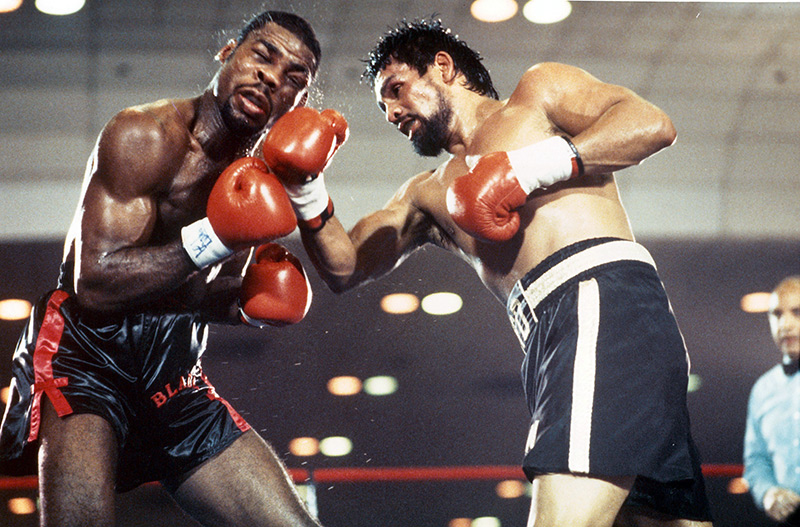
Roberto Duran’s WBC middleweight title-winning split-decision over Iran Barkley was Ring’s 1989 Fight of the Year. Photo / The Ring archive
A popular choice for the greatest lightweight of all time, Duran dominated the class for almost six years before rising to welterweight and capturing a second world title. Duran was Ring’s number three contender when he toppled Ken Buchanan for the Ring and WBA honors to begin his reign. Over twelve successful title defenses, Duran posted three wins against number one contenders. Two of those three came in avenging his first loss in a non-title affair versus Esteban De Jesus. Their third and final bout allowed Duran to unify the class in his last lightweight contest.
Duran defeated a pair of ranked welterweights to set up his greatest victory, a decision over Sugar Ray Leonard for the welterweight title. After the Leonard victory, Duran’s career mark stood at 72-1 with a mark of 14-1 against Ring-ranked opponents. Results were inconsistent from there. Wins over Davey Moore and Iran Barkley gave Duran belts in his third and fourth divisions and he competed favorably against middleweight great Marvelous Marvin Hagler in a loss. Duran’s final win against a ranked foe can be underrated. Jorge Castro was less than two years removed from a WBA middleweight title reign and Castro would go on to challenge for cruiserweight gold.
Missing Quality: Duran had multiple quality wins against fighters who would be ranked, were recently ranked, or would return to the rankings after he defeated them. For instance, Duran handed excellent future featherweight titlist Ernesto Marcel his only stoppage loss in 1970 before either entered a Ring top ten. In September 1973, Duran successfully defended his lightweight crown against unranked Guts Ishimatsu with a tenth round stoppage. Ishimatsu wouldn’t crack Ring’s top ten until upsetting Rodolfo Gonzalez for the WBC belt in 1974. Jimmy Robertson fell out of the Jr. welterweight top ten roughly six months before losing to Duran in 1973. A 1974 win over Hector Matta came between periods when Matta was ranked at Jr. welterweight while a 1975 win over Edwin Viruet came less than a year before Viruet cracked the rankings. Wins in the late 70s over regular contenders Adolfo Viruet, Monroe Brooks, and Jimmy Heair all came at moments when those three were outside the rankings. Future super middleweight title challenger Juan Carlos Gimenez was a couple years from entering the rankings when Duran beat him in 1988.
Scoring Results:
Hiroshi Kobayashi KO 7 – (2-) – 130 – 12/71
Ken Buchanan TKO 13* – (C) – 135 – 08/72
Esteban De Jesus L 10 – (3) – 135 – 01/73
Hector Thompson TKO 8 – (6+) – 140 – 08/73
Esteban De Jesus KO 11 – (1) – 135 – 05/74
Ray Lampkin KO 14 – (1) – 135 – 04/75
Leoncio Ortiz KO 15 – (7+) – 140 – 02/76
Saoul Mamby UD 10 – (10+) – 140 – 06/76
Lou Bizzarro KO 14 – (5+) – 140 – 07/76
Vilomar Fernandez KO 13 – (4) – 135 – 03/77
Edwin Viruet UD 15 – (2) – 135 – 11/77
Esteban DeJesus TKO 12 – (1) – 135 – 03/78
Carlos Palomino UD 10 – (7) – 147 – 08/79
Joseph Nsubuga RTD 4 – (9) – 147 – 03/80
Sugar Ray Leonard UD 15* – (C) – 147 – 08/80
Sugar Ray Leonard TKO by 8* – (2) – 147 – 01/81
Nino Gonzalez UD 10 – (9+) – 154 – 09/81
Wilfred Benitez L 15 – (1) – 154 – 02/82
Kirkland Laing L 10 – (UR) – 154 – 10/82
Pipino Cuevas TKO 4 – (5-) – 147 – 03/83
Davey Moore TKO 8 – (2) – 154 – 07/83
Marvelous Marvin Hagler L 15 – (C) – 160 – 12/83
Thomas Hearns TKO by 2 – (C) – 154 – 08/84
Robbie Simms L 10 – (3) – 160 – 08/86
Iran Barkley SD 12 – (2) – 160 – 03/89
Sugar Ray Leonard L 12 – (1+) – 168 – 03/90
Pat Lawlor TKO by 6 – (UR) – 160 – 06/91
Vinny Pazienza L 12 – (4) – 160 – 10/94
Vinny Pazienza L 12 – (5) – 168 – 04/95
Hector Camacho L12 – (7–) – 147 – 10/96
Jorge Castro L10 – (5-) – 160 – 05/97
Jorge Castro UD10 – (6) – 168 – 10/97
#32 – Barney Ross
Career Record: 74-4-3, 2 No Decisions (22 KOs)
First Ring Ranking: #10 Lightweight (July 1931)
Last Ring Ranking: #1 Welterweight (August 1938)
Record vs. Ring-rated Opponents: 14-2-1
Overall Score Rank: 17
Peak Score Rank: 24
Win Total Rank: 80
Ring Magazine Championships: Lightweight (1933-35), Welterweight (1934, 35-38)

An illustration of Barney Ross on the November 1933 cover of The Ring. Ross was Ring’s 1935 Fighter of the Year (and was retroactively awarded the 1933 honor.)
A masterful boxer with exceptional stamina, Ross ended Tony Canzoneri’s first lightweight title reign and went on to win the welterweight title twice. Ross rose to number one contender at lightweight in the April 1933 issue but entered his challenge of Canzoneri ranked number two. Ross was ranked as champion at lightweight or welterweight, and briefly both, for all but one issue from there until his loss to Henry Armstrong, a span of five years.
Ross defended the welterweight title successfully only twice, both in his second reign. Of his 14 wins against ranked opponents, five came against reigning champions or number one contenders with two more against men ranked number two in their class. In the four-way rivalry with Canzoneri, Billy Petrolle, and Jimmy McLarnin, Ross posted the best mark of the bunch going 6-1 and some observers felt Ross deserved the nod in the second of his three memorable bouts with McLarnin as well.
Missing Quality: Ross had additional wins over Gordon Wallce, Ray Miller, Bobby Pacho, and Baby Joe Gans, among others, before or after they had stints in the rankings. A more significant near miss merits mention. Writing in the November 1932 issue, Eddie Borden stated, “we will eliminate both the junior-lightweight and junior-welterweight rankings in each issue of The Ring to conform with the ruling instigated by the N.B.A.” The decision to cease recognizing titles at Jr. welterweight didn’t mean fighters were not still competing for them for a time. Historians recognize Ross as a champion in three weight classes. Ross defeated Canzoneri for his claim to the Jr. welterweight crown as well as the lightweight title in their first contest. Ring’s recognized Jr. welterweight champion in the October 1932 issue was Sammy Fuller. Ross’s win over Fuller on November 17, 1933 was veritably a unification bout, even if the Jr. welterweight title wasn’t universally recognized any longer. Ross continued to defend his claim at Jr. welterweight until 1935, and is credited with ten total defenses. Ross continued to be recognized by Ring as lightweight champion until the same year. That means a strong case can be made that when Ross defeated McLarnin for his first welterweight crown in 1934 it was Ross, and not Henry Armstrong, who became the first champion in three weight classes at the same time.
Scoring Results:
Billy Petrolle UD 10 – (3+) – 147 – 04/33
Joe Ghnouly W 10 – (8) – 135 – 06/33
Tony Canzoneri MD 10* – (C) – 135 – 07/33
Tony Canzoneri SD 15 – (1) – 135 – 10/33
Sammy Fuller MD 10 – (5) – 135 – 12/33
Billy Petrolle UD 10 – (1+) – 147 – 03/34
Frankie Klick D 10 – (4) – 135 – 04/34
Jimmy McLarnin SD 15* – (C+) – 147 – 07/34
Jimmy McLarnin L 15* – (1) – 147 – 10/34
Bobby Pacho W 12 – (3+) – 147 – 01/35
Frankie Klick UD 10 – (2) – 135 – 03/35
Jimmy McLarnin UD 15* – (C) – 147 – 07/35
Ceferino Garcia W 10 – (7) – 147 – 11/35
Ceferino Garcia UD 10 – (3) – 147 – 01/36
Izzy Jannazzo UD 15 – (4) – 147 – 01/37
Ceferino Garcia UD 15 – (2) – 147 – 11/37
Henry Armstrong L 15* – (C–) – 126 – 07/38
#31 – Larry Holmes
Career Record: 69-6 (44 KOs, 1 KOBY)
First Ring Ranking: #10 Heavyweight (March 1976)
Last Ring Ranking: #6 Heavyweight (July 1995)
Record vs. Ring-rated Opponents: 20-5 (14 KOs, 1 KOBY)
Overall Score Rank: 40
Peak Score Rank: 45
Win Total Rank: 34
Ring Magazine Championships: Heavyweight (1980-85)

Larry Holmes was Ring’s 1982 Fighter of the Year.
“The Easton Assassin” was the last of the great 1970s heavyweights, dominating the flagship class for years behind a punishing left jab. Holmes spent two years in the top ten before securing the first of two fights with Earnie Shavers. Holmes was number three in the rankings on the eve of his memorable war with Ken Norton for the WBC belt and never looked back. Holmes gained recognition as Ring’s champion in the June 1980 issue when Mike Weaver, whom Holmes had already defeated, won the WBA belt. Holmes aligned his claim to the title with the lineage of the crown by defeating Muhammad Ali later in the year.
Holmes would forsake the WBC belt for the recognition of the fledgling IBF beginning with his defense against “Bonecrusher” Smith. Combining his reigns as Ring, WBC, and IBF champion, Holmes had a total of 20 consecutive defenses. Holmes first 14 title fights were all against Ring ranked opponents, with 17 of 20 defenses against Ring’s top ten. Holmes would never regain any title after losing it to light heavyweight champion Michael Spinks, denying Holmes his quest to match Rocky Marciano’s heavyweight mark of 49-0 by a single win. Holmes came closest to winning another belt in scaring WBC titlist Oliver McCall in 1995.
Missing Quality: While Holmes never unified the division during his reign, his consistency was in stark contrast to the hot potato passage of the WBA, and later WBC, belt. Mike Weaver, Trevor Berbick, and Smith would all go on to win belts after failed challenges of Holmes. Tim Witherspoon, who gave Holmes one of his toughest defenses, would win both.
Scoring Results:
Earnie Shavers UD 12 – (7) – Hvy – 05/78
Ken Norton SD 15 – (2) – Hvy – 08/78
Alfredo Evangelista KO 7 – (6) – Hvy – 01/79
Ossie Ocasio TKO 7 – (5) – Hvy – 05/79
Mike Weaver TKO 12 – (8) – Hvy – 08/79
Earnie Shavers TKO 11 – (3) – Hvy – 11/79
Lorenzo Zanon KO 6 – (7) – Hvy – 03/80
Leroy Jones TKO 8 – (6) – Hvy – 05/80
Scott LeDoux TKO 7 – (10) – Hvy – 08/80
Muhammad Ali RTD 10 – (5) – Hvy – 11/80
Trevor Berbick UD 15 – (7) – Hvy – 05/81
Leon Spinks TKO 3 – (3) – Hvy – 08/81
Renaldo Snipes TKO 11 – (10) – Hvy – 12/81
Gerry Cooney TKO 13 – (3) – Hvy – 07/82
Randall Cobb UD 15 – (9) – Hvy – 01/83
Tim Witherspoon SD 12 – (10) – Hvy – 06/83
Marvis Frazier TKO 1 – (10) – Hvy – 12/83
James Smith TKO 12 – (9) – Hvy – 12/84
David Bey TKO 10 – (3) – Hvy – 05/85
Michael Spinks L 15* – (C–) – 175 – 11/85
Michael Spinks L 15 – (C) – Hvy – 06/86
Mike Tyson TKO by 4 – (1) – Hvy – 04/88
Ray Mercer UD 12 – (5) – Hvy – 05/92
Evander Holyfield L 12 – (1) – Hvy – 10/92
Oliver McCall L 12 – (2) – Hvy – 07/95
***
Click here to read 100-91.
Click here to read 90-81.
Click here to read 80-71.
Click here to read 70-61.
Click here to read 60-51.
Click here to read 50-41.
***
Scoring Details:
Scoring for total points and peak points relied on a base 11-point scale (i.e. a champion and the top 10 contenders).
A win over the champion of one’s weight class, in a title or non-title fight, was worth 11 points, a No. 1 contender was worth 10, etc.
Losses worked in reverse. A loss to the champion was a one-point deduction sliding to 11 for a loss to the No. 10 contender.
Losses to unranked opponents drew a universal 12-point deduction. Draws against ranked opponents were worth half a win; draws against unranked opponents were a six-point deduction.
Fighters were then given a ranking in each scoring category: overall total, peak score (the highest point their points for wins and losses reached), and ranked wins.
Wins and losses to opponents in higher and lower divisions were included. A formula based on body weight percentage differences between divisions of ranked fighters, rather than scale weights of the fighters, was applied.
For instance, if a No. 2-ranked bantamweight defeated the No. 2-ranked featherweight, 126 was divided by 118 and then multiplied by standard win/loss points, making the win worth 9.61 points to the bantamweight and the loss a deduction of 3.2 points for the featherweight. If the featherweight won, 118 would be divided by 126 with the win worth 8.42 points for the featherweight and the loss meaning a deduction of 2.81 points for the bantamweight.
The exception was fighters moving up to face heavyweights. There is no specific heavyweight ceiling so the formula divides the weight limit of the smaller fighter’s division against the actual weight of the heavyweight.
Everyone who finished in the top 100 of preliminary research for those three categories was moved into a final pool of what came out to 150 fighters. Win total ties were broken based on peak score. Their rankings in each category were then averaged into a final score.
To best display the range of data, they were then divided into four groups to settle on the final 100.
Group one: anyone who finished in the top 100 of all three scoring categories or whose scoring average was higher than those who did. (1-64).
Group two was anyone else who finished in the top 100 for peak score and ranked wins but not overall points (65-69).
Group three was derived from fighters who scored in the top 75 of any of the three scoring categories or whose final scoring average was higher than what would otherwise be the bottom ten of the top 100 (70-100).
The final average score was used to order the fighters in each group for those who made the top 100.
The study tried to respect the varying standards The Ring has used to rank fighters over the last century. For instance, champions haven’t automatically secured the top spot in every era of Ring rankings. Mike McTigue was the light heavyweight champion for the inaugural rankings in 1925 and was rated fourth.
For the 1925 rankings, and the period when Ring didn’t recognize single champions from 1989 to 2001, only 10 fighters per weight class were ranked. The points scale shifted for those years. The No. 1-ranked fighter became the 11-point win, deduction for an unranked loss was eleven points, and unranked draws were a 5.5-point deduction.
The 1926 and subsequent annual rankings prior to the introduction of monthly rankings included more than 10 fighters so the first 11 were all factored in.
The study is primarily based on monthly rankings. However, for a lengthy period of time the February, and later March, issue of the magazine would only feature the annual ratings for the year. Those were treated as that month’s rankings and, if needed, were reordered as champion and top 10 to maintain consistency.
Rankings from 1925-1928 had no monthly movement. The solution was to include all results from 1924 in evaluating 1925 and then applying six-month increments with spare exception near mid-year dates until the debut of monthly rankings; i.e. results from January-June 1925 used the 1925 annual and the rest of the year used 1926’s.















